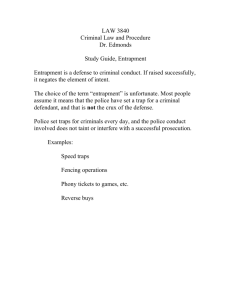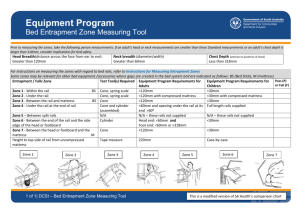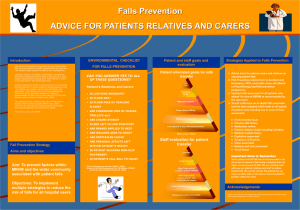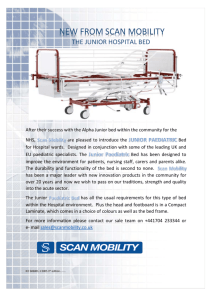To be completed only when/if bed rails or bed sticks have been
advertisement
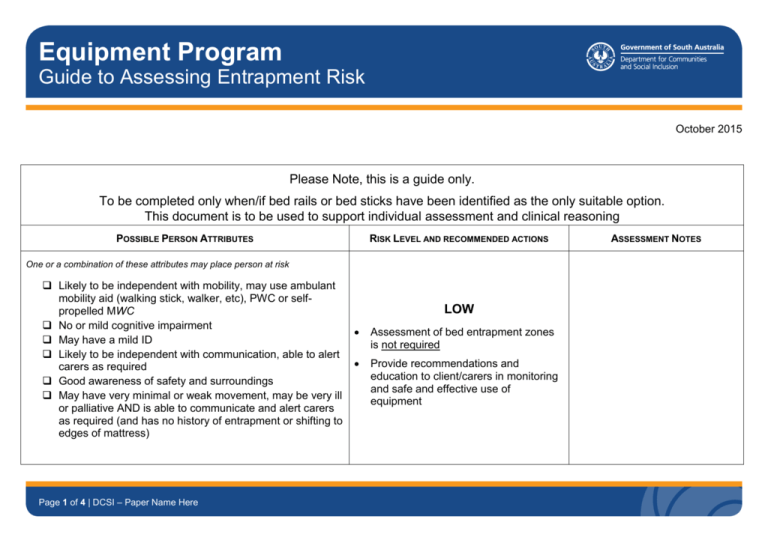
Equipment Program Guide to Assessing Entrapment Risk October 2015 Please Note, this is a guide only. To be completed only when/if bed rails or bed sticks have been identified as the only suitable option. This document is to be used to support individual assessment and clinical reasoning POSSIBLE PERSON ATTRIBUTES RISK LEVEL AND RECOMMENDED ACTIONS One or a combination of these attributes may place person at risk Likely to be independent with mobility, may use ambulant mobility aid (walking stick, walker, etc), PWC or selfpropelled MWC No or mild cognitive impairment May have a mild ID Likely to be independent with communication, able to alert carers as required Good awareness of safety and surroundings May have very minimal or weak movement, may be very ill or palliative AND is able to communicate and alert carers as required (and has no history of entrapment or shifting to edges of mattress) Page 1 of 4 | DCSI – Paper Name Here LOW Assessment of bed entrapment zones is not required Provide recommendations and education to client/carers in monitoring and safe and effective use of equipment ASSESSMENT NOTES POSSIBLE PERSON ATTRIBUTES RISK LEVEL AND RECOMMENDED ACTIONS ASSESSMENT NOTES One or a combination of these attributes may place person at risk Likely to require assistance for transfers and mobility, likely to be able to weight bear May have more complex equipment needs for pressure management MEDIUM Assessment of bed entrapment zones is required (Refer to Bed Entrapment Zone Measuring Tool and Instructions for Measuring Entrapment Zones) OR May be able to move minimally in bed, demonstrates moderate to severe cognitive impairment AND cannot communicate/alert carers Some zones may apply for equipment other than bed rails and bed sticks (eg mattress, self-help pole) Take all possible steps to eliminate non-compliant zones Educate client and carers in safe, effective use and monitoring of equipment May have some history of entrapment Medications may impact on night time behaviours and levels of arousal and alertness OR May show repetitive behaviours tremors/movement disorders that may impact on motor planning and coordinated movement, may demonstrate moderate cognitive impairment (eg unaware of risks), may be unable to consistently alert carers Page 2 of 4 | DCSI – Guide to Assessing Entrapment Risk Equipment Program: Telephone:1300 295 786 Fax:1300 295 839 POSSIBLE PERSON ATTRIBUTES RISK LEVEL AND RECOMMENDED ACTIONS ASSESSMENT NOTES One or a combination of these attributes may place person at risk Likely to be dependent for transfers and mobility, most likely use of hoist for transfers May have uncontrolled movement or weak movement May get stuck in a position May not be able to call out or seek assistance if needed May have impaired cognition – unable to understand risks May have seizures but are generally controlled by medication May have a history of entrapment issues May be at risk of toppling over rails due to uncontrolled movement One or a combination of these attributes may place person at risk: May have night time behaviours of concern Usually very mobile May wander and is inconsistently able to alert carers May have significant cognitive impairment May be confused or agitated HIGH Assessment of bed entrapment zones is required (Refer to Bed Entrapment Zone Measuring Tool and Instructions for Measuring Entrapment Zones) Some zones may apply for equipment other than bed rails and bed sticks (eg mattress, self-help pole) Take all possible steps to eliminate non-compliant zones Educate client and carers in safe, effective use and monitoring of equipment Medications may impact on night time behaviours and levels of arousal and alertness Hallucinations/ illusions may impact on night time behaviours Page 3 of 4 | DCSI – Guide to Assessing Entrapment Risk Equipment Program: Telephone:1300 295 786 Fax:1300 295 839 POSSIBLE CLIENT ATTRIBUTES RISK LEVEL AND RECOMMENDED ACTIONS ASSESSMENT NOTES One or a combination of attributes may place person at risk: HIGH/ EXTREME Likely to be dependent for all transfers, most likely use hoist for transfers Likely to have significant uncontrolled movement or weak movement Assessment of bed entrapment zones is required (Refer to Bed Entrapment Measuring Tool and Instructions for Measuring Entrapment Zones) Some zones may apply for equipment other than bed rails and bed sticks (eg mattress, self-help pole) Likely to have significant health and medical issues (eg respiratory, swallowing, pressure) requiring complex intervention Take all possible steps to eliminate noncompliant zones Educate client and carers in safe, effective use and monitoring of equipment May get into positions but not out of them – i.e. may get stuck in positions Likely to have significant cognitive impairment/lack of insight into risks Hallucinations/ illusions may impact on night time behaviours Medications may impact on night time behaviours and levels of arousal and alertness Unlikely to be able to call out or request carer assistance May have uncontrolled or unpredictable seizures May have a history of entrapment issues Page 4 of 4 | DCSI – Guide to Assessing Entrapment Risk Equipment Program: Telephone:1300 295 786 Fax:1300 295 839
